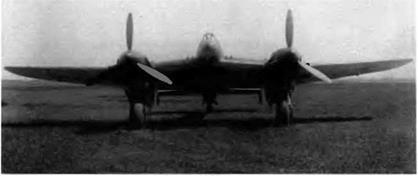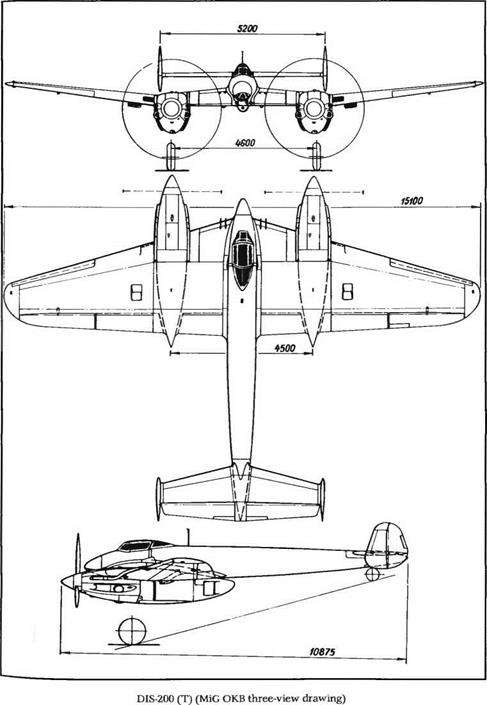DIS-200 Series
DIS 200/Т
At the end of the 1930s the VVS could operate a fleet of long-range heavy bombers and tactical medium-range bombers but did not have the escort fighters needed to protect them. As early as 1940, the newly formed design bureau had tackled the development of a long-range escort fighter capable of performing high-speed reconnaissance, light bombing, and torpedoing roles. In the preliminary design it was planned to use new, efficient diesel engines developed by A. D. Charomskii, the M-40 and M-30, which would give the aircraft a much greater range because of their low specific fuel consumption.
But neither of these diesels were as yet reliable, so it was decided to equip the prototype—whose factory code letter was T—with two liquid-cooled in-line 1,030 kW (1,400 ch) AM-37s driving three-bladed variable-pitch propellers. The exhaust collectors were bent and extended above the wing upper surface. Fuel was distributed into six tanks, four in the wing center section and two behind the cockpit. Two oil coolers were located on each side of the engine cowlings as on the MiG-3. The glycol was cooled by two air scoops placed on each side of the cowlings, and the corresponding outlets were located beneath the trailing
|
The air scoops of the engine coolant radiators on the DIS-200 (T) are on each side of both engine nacelles. The corresponding outlets were placed just under the wing’s trailing edge. |
edge of the wing. The engine supercharger inlets were located in the leading edge.
The single-seat, twin-engine T prototype had a low wing, a twin fin configuration, and a structure composed primarily of wood rather than scarce light alloys. The flight tests led to the installation of slats on the wing leading edge. On the trailing edge, to complement the two-segment flaps, high lift was augmented by specially designed ailerons, which could be symmetrically lowered to 20 degrees. The latter feature was a great novelty at the time; today they are known as flaperons. The main gear (950 x 300 tires) retracted into the engine nacelles and the tail wheel into the fuselage, and both were pneumatically operated—a first in the USSR.
The cockpit was equipped for instrument flying, and the pilot had an oxygen dispenser and a radio receiver at his disposal. The sliding aft canopy could be jettisoned. The front, rear, sides, and underside of pilot’s seat were protected by armored plates, and the lower part of the fuselage nose was glazed to give the pilot some downward vision.
The DIS-200 T fighter variant was especially powerful, with one 23- mm VYa cannon in a removable fairing under the nose to complement two 12.7-mm BS and four 7.62-mm ShKAS machine guns on the leading edge of the wing. The cannon fairing could be replaced by a 1,000-kg (2,200-pound) bomb or a torpedo.
The T started its taxiing tests on 15 May 1941 and made its first flight at the end of the month, with A. I. Zhukov at the controls. Flight tests went on all summer at the Khodinka airfield near Moscow and were conducted by Zhukov and V. N. Savkin, an Nil WS test pilot.
|
|
Series production of the T was to have taken place at factory no. 1, but the Germans invaded just as the first tests got under way. The aircraft was moved to Kazan, and flight tests were not continued.
In some OKB documents the fighter version is referred to as the MiG-5 and the bomber version as the MiG-2. DIS stands for Dalniy Istrebityel Soprovozhdeniya: long-range escort fighter. The DIS-200 had three competitors: the Tairov Ta-3 (OKO-6bis), the Polikarpov TIS, and the Grushin Gr-1.
Specifications
Span, 15.1 m (49 ft 6.5 in); length, 10.875 m (35 ft 8.1 in); wheel track, 4.6 m (15 ft 1.1 in); wing area, 38.9 m2 (418.7 sq ft); empty weight, 6,140 kg (13,530 lb); takeoff weight, 8,060 kg (17,765 lb); fuel, 1,920 kg (4,230 lb); wing loading, 207.2 kg/m2 (42.4 lb/sq ft).
Performance
Max speed, 610 km/h at 6,800 m (329 kt at 22,300 ft); service ceiling, 10,800 m (35,425 ft); range, 2,280 km (1,415 mi); endurance, 5 h; climb to 5,000 m (16,400 ft) in 5.5 min.












